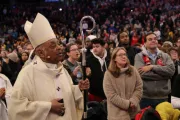Rather, it’s a question of how cultural changes—readily reflected in the Pew study—will impact Catholic practice and identity.
No matter who happens to occupy the White House or have control of Congress in the coming decades, committed Catholics in the United States will feel more and more, not just as ‘strangers in a strange land’ but as aliens in an openly hostile environment, in a secular culture that wishes to render Catholicism insipid, innocuous, and largely indistinguishable from itself.
While large percentages of cultural Catholics will continue to be assimilated (to not say digested) by that secular culture, to the eventual loss of their religious practice and Christian faith altogether, it makes all the sense in the world to expect that committed Catholics will find themselves bolstered more and more by tightknit communities of Catholic belief and practice. If truth be told, this dynamic has already been going on for years.
And, yes, of course I am thinking here of Pope Benedict’s (then Cardinal Joseph Ratzinger’s) 1997 interview with Peter Seewald in Salt of the Earth. In that interview, Benedict mused on the future of the Church in these terms:
Perhaps the time has come to say farewell to the idea of traditionally Catholic cultures. Maybe we are facing a new and different kind of epoch in the Church’s history, where Christianity will again be characterized more by the mustard seed, where it will exist in small, insignificant groups that nonetheless live an intensive struggle against evil and bring the good into the world – that let God in.
That vision was echoed in a 2003 interview he gave to EWTN’s Raymond Arroyo. In that interview, then Cardinal Ratzinger took a question about the future of the Church and was asked to give his own interpretation of what had become by then a major theme of Pope St. John Paul’s pontificate: “the new springtime of evangelization.” His reply echoed the response to Seewald: “The essential things in history [of the Church],” observed Benedict, “begin always with smaller, convinced communities…communities with the élan of the faith.”
In our present circumstances, we can be quite sure this is a vision of what we will look like as a Church: convinced communities where the faith is lived robustly and dynamically; communities composed of relatively smaller numbers of Catholics living their faith on their sleeves; communities full of joy and irradiating the faith; communities—it goes without saying—that live in communion with the institutional Church and in docility to the local bishop as well; communities, not of messiah complexes and misguided reform, but of fidelity. Idyllic? Perfect? Hardly. There will be plenty of problems and tensions therein as well. Yet, how resist the hopeful thought that they should act as creative minorities engaged in a long, twilight struggle to avoid becoming the next European-style spiritual wasteland of empty cathedrals and emasculated Catholicism?
To be sure, Pope Benedict was not thinking here so much of a return to the catacombs, as of communities—arguably, on the whole, parish communities—in which Catholics live in a state of intense—or more precisely, intentional—discipleship. These communities will be places, by God’s grace, in which Catholics who have been given the grace of a personal and life-altering encounter with the risen Lord will guide other Catholics to a similar encounter.
So, if we are looking for ways to stop the hemorrhaging of Catholics from the Church, our decades-old approach of reluctantly accepting lukewarm Catholic practice as “normal” is going to get us nowhere—we now have empirical proof of that. As Catholic evangelist, and author of Forming Intentional Disciples, Sherry Weddell observed, reacting to the Pew study, “cultural Catholicism is dead as a retention strategy.”
Fortunately, there are plenty of parishes across the U.S. headed by pastors who understand this. They get it. They are pastors who understand that their congregations need to receive in their Sunday homilies, not psychobabble, but kerygma; not fluff, but the great story of salvation; not empty niceties, but the irresistible beauty of Jesus Christ. And these priests employ new, out-of-the-box approaches to parish evangelization, religious education, youth ministry and marriage preparation. They know that the primary task before them is to invite their flocks to a living encounter with Jesus, and to a life of discipleship. (And by the way—our seminarians get it as well).
Some might want to suggest that small, robust networks of vibrant Catholicism are by far preferable to large populations of lukewarm, innocuous Catholics. Smaller is better, it is suggested, and perhaps this should be adopted as a strategy. As for the lukewarm who are nearing the exit doors, well, good riddance.
(Column continues below)
Subscribe to our daily newsletter
Of course, such an attitude is nothing short of diabolical. Nor would it seem that Pope Benedict was thinking of ‘small and robust’ as a strategy so much as the upshot of unavoidable historical circumstances.
So, as we find ourselves, nonetheless, living our faith lives more and more from within these potent Catholic nuclei, let’s forego the bunker mentality, and the remnant mindset. Our attitude must remain that proposed by Pope Francis, the attitude of those fully caught up in the drama of the Church as field-hospital, reaching out to the spiritually marginalized, to cultural Catholics, to the religiously “unaffiliated,” to the extremities of a Church troubled by deep internal tensions and profoundly in need of the experience of Jesus Christ.


